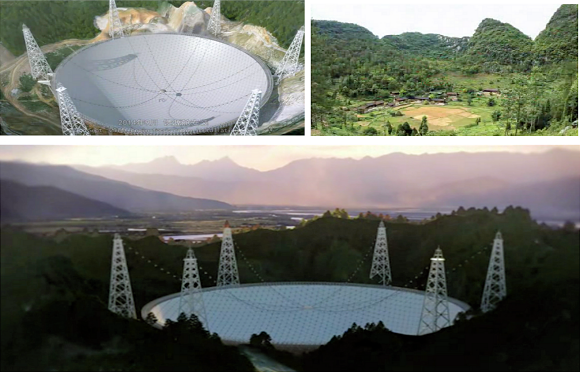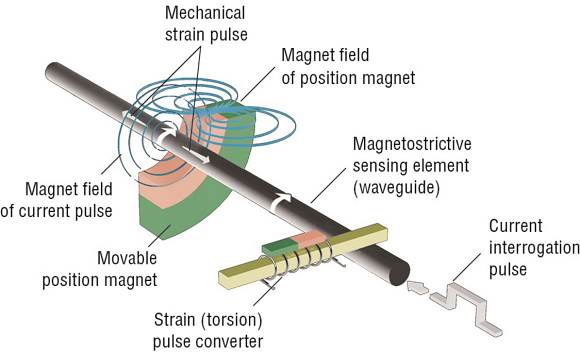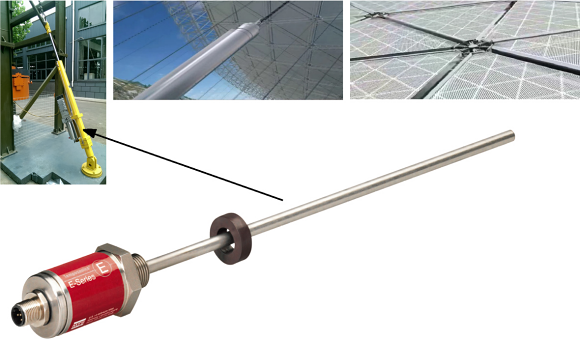
Intro
Despite the prolonged spell of financial austerity currently being experienced, there is still sizeable investment into scientific research concerned with studying the universe around us and how we actually got here. In Europe for example, the Large Hadron Collider situated just outside Geneva, which has taken over a decade to construct, is finally fully functional. This huge particle physics project has cost somewhere in the region Euro 4.5 billion. Meanwhile, the Mars Rover expedition continues its ongoing pursuit for signs that our closest neighboring planet may have once had water and therefore potentially been able to sustain life.
Another exciting scientific endeavor, which is now close to reaching completion, is China's Five Hundred Meter Aperture Spherical Radio Telescope (FAST). This huge radio telescope (see figure 1) is being assembled in an isolated location in Guizhou Province, in the south west of the country. The construction of this wonder of science is expected to cost in excess of Euro 100 million by the time it is finished.

Fig. 1: FAST, situated in the remote mountainous terrain of Chinese province of Guizhou, is destined to be largest radio telescope to date.
Parts & Assembly
Radio telescopes rely on a reflective dish which focuses all the radio waves incident upon it directly at a receiver at its zenith. FAST, as the name would suggest, will have a 500m diameter reflector dish. Once it is completed, in mid-2016, it will be the world's largest radio telescope, considerably bigger than the 305m diameter radio telescope based at the Arecibo Observatory in Puerto Rico, which until now has held that honor. It will also be the most sensitive radio telescope ever built, approximately three times more sensitive than Arecibo. This means that it will be able to pick up radio signals from more than 7 billion light years away.
Because of the overall scale of FAST, use of the existing natural landscape has been necessary. The telescope will have a total reflective area of almost a square km, which if this was a conventional radio telescope design it would require the support of a dish weighing 11,000 tons in total. As a result, rather than being a free-standing edifice, the telescope is being built within a vast valley basin measuring over 800m across.
The reflector dish will, in this case, focus radio waves coming from space over a frequency range spanning from 300MHz to 5.1GHz toward a receiver hung from a series of cables. It will be possible for this receiver to be moved across the face of reflector using these cables in order to adjust the focal point.
Positioning in a suitable valley basin was not the only geographical factor to be considered when selecting where to place FAST however. Since the chosen site is 170km away from the nearest major city, it has little radio pollution to worry about. As a result the received data is not impinged upon by obvious sources interference.
The Task
Much like the LHC, FAST has been a long time in the making - requiring a monumental engineering effort. The original planning for this astronomical research facility began way back in 1994. The initial excavating of the basin took place in early 2012, with construction getting under way later that year.
The size of FAST is almost an order of magnitude greater than the largest conventional radio telescopes such as the Lovell telescope at Jodrell Bank in the UK, or Green Bank in West Virginia, USA. Due to the huge dimensions of FAST's parabolic reflector, and the fact that it is set inside a valley, it cannot be moved, as was possible with radio telescopes in the past. Therefore an alternative method has to be employed in order to orientate the reflector in such a way that it can investigate particular areas of the cosmos.
FAST's reflecting surface is therefore not a single solid structure, instead it consists of an amalgamation of 4,450 triangular aluminum plates. Every one of these plates can be moved individually via its own motor system. This means that reflection parabolas can be created in different directions.
Solutions
Thanks to its revolutionary movable reflecting plates, FAST will enable exploration of all parts of the night's sky, with a deviation of up to 40° from the telescope's zenith, compared with a 20° maximum deviation from the zenith for Arecibo, which has a reflective surface that is completely fixed. It will therefore have the capacity to simultaneously collect astronomical data for analysis from 19 different sky regions, whereas Arecibo can only manage a total of 7.
The position of the reflective plates is absolutely crucial, as even the slightest error here could have a potentially enormous effect on the quality of data acquired. Equally important is the operational longevity of the reflector's positioning mechanism. With so many reflecting elements involved, the risk of reliability issues arising relating to the position of these elements must be kept to an absolute minimum. Otherwise the costs in terms of operationally downtime, as well as the expense associated with carrying out repairs, could be substantial.
For the purpose of controlling movement of the reflective surface, there are hydraulic cylinders under all of FAST's reflective plates. These are accompanied by electro-hydraulic actuators through which movement is initiated. The cylinders each incorporate one of MTS Sensors' E-Series magnetostrictive position sensing devices, based on the company's proprietary Temposonics technology.
The magnetrostrictive effect is where a change in the dimensions of a ferromagnetic material is caused by the presence of a magnetic field. Using the Temposonics sensing mechanism (see figure 2), position can be accurately determined through the momentary interaction between two magnetic fields.

Fig. 2: Temposonics time-based magnetostrictive position sensing mechanism in action.
One field comes from a movable permanent magnet that passes along the outside of the sensor. The other field comes from a current pulse applied along a ferromagnetic waveguide which runs parallel to the direction in which the permanent magnet moves. When these two magnetic fields interact with one another a sonic torsion pulse is created. This passes through the waveguide and is detected by the sensing element. By precise measurement of the time period between the current pulse being applied and the torsion pulse being received it is possible to derive an exact value of the distance to the movable magnet.
This magnetostrictive sensing method provides an accurate, non-contact way for measuring position that is highly suited to deployment in the most challenging of environments. Sensors utilizing this technology are effectively wear-free. They are able to cope with vibrations, heavy shocks, high pressures, and elevated temperature levels without any loss in their reliability or performance. As the output from sensors based on this method corresponds to an absolute position rather than a relative value, the need for recalibration work is avoided.
The E-Series specified for the FAST project combines ruggedness, cost-effectiveness and compactness (see figure 3). These sensing units are housed inside IP69K-rated enclosures, which help to protect them against liquid ingress, high temperature and high pressure conditions, as well as allowing them to cope with wash downs. Their stainless steel construction makes them suitable for placement within hydraulic cylinders. Continued accuracy is underlined by the linearity deviation of <0.02% full strength and 0.005% repeatability full strength. They each have a digital synchronous serial interface (SSI) output which facilitates system integration and ensures high levels of signal quality.

Fig. 3: E-Series magnetostrictive sensors form the basis of the position control system for each of FAST's 4,450 reflective plates.
The stroke length range of E-Series units goes from 50mm right up to 2500mm. They can cope with 100g shock (in accordance with the EN 60068-2-27 standard) and 15g vibrational force at frequencies of 10Hz to 2000 Hz (in accordance with EN 60068-2-6). An operating temperature range covering -40°C to 75°C is supported, as is a 90% relative humidity figure.
About the Author
Robert Luong is Technical Marketing Manager at MTS Sensors. He has worked for the company for a period of 3 years and is based at its Lüdenscheid site in Germany. Prior to joining MTS Sensors, Robert spent 12 years in engineering and product marketing positions with Moog. He has an MBA from ESSEC & Mannheim Business School and a degree in Electrical & Electronics Engineering from Ruhr University Bochum.
Related Stories
What's LVIT Technology And What's So Good About It?
How Linear Position Sensors Ensure Efficient Gas Turbine Operations
Fluid Level Sensors – More Than Just an On/Off Signal